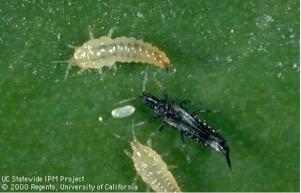Thrips
-
AboutThrips are tiny, slender insects with hairs on their wing margins.
 Cuban laurel thrips, yellowish nymphs, black adult, and pale egg. Photo by Jack Kelly Clark/UC IPM
Cuban laurel thrips, yellowish nymphs, black adult, and pale egg. Photo by Jack Kelly Clark/UC IPMThey are less than one-twentieth inch long and their color varies depending on the species and life stage.
Thrips hatch from eggs and develop through two feeding and two non-feeding stages before developing into adults.
Most pest thrips feed while hidden, often in buds and shoot tips or beneath sepals; you’ll often observe the damage before seeing the thrips.
Greenhouse thrips and western flower thrips are two common pest species in landscapes.
Certain thrips are beneficial predators of some insects and mites.
-
CategoryInsect
-
Signs/Symptoms
Damage often isn’t apparent until tissue grows and expands. Look for:
Scabby, silvery to dark brown discoloration on fruit, leaves, or petals
Dark specks of excrement on fruit or leaves
Distorted, curled, galled, or dead shoot tips and leaves
Be certain that pest thrips are present and causing damage before taking control action. Harsh weather, inadequate plant care, pathogens, and other invertebrates can cause similar-looking damage.
Shake foliage or flowers over white paper to see if this dislodges any thrips.
Hang blue or bright yellow sticky traps to detect flying thrips.
-
Where
Adult thrips overwinter in plant debris, bark, or other materials. Thrips feed while hidden often in buds and shoot tips or beneath sepals.
-
When
Adult thrips overwinter in plant debris, bark, or other materials. They become active in early spring and lay eggs in plant tissue.
-
Prevent
Thrips species that feed on many different plant species often move into gardens and landscapes when plants in weedy areas or grasslands begin to dry in spring or summer. Avoid planting susceptible plants next to these areas, and control nearby weeds that are alternate hosts of pest thrips.
Grow plants that are well-adapted to conditions at that site.
Provide appropriate cultural care to keep plants vigorous and increase their tolerance to thrips damage.
Keep plants well irrigated, and avoid excessive applications of nitrogen fertilizer, which may promote higher populations of thrips.
Old, spent flowers can harbor thrips; remove and dispose. The general benefit of this practice in landscapes is unknown; and old blossoms can shelter beneficial predators of thrips.
Investigate the availability of resistant cultivars.
-
Manage
Thrips are difficult to control. Combine methods for best results:
Manage thrips by combining good cultural care, pest exclusion, thrips-resistant plants, and less toxic insecticides that are softer on natural enemies.
Find out what species you have and research the best approach; see Pest Notes: Thrips.
Conserve parasites and predators by avoiding persistent pesticides.
Avoid overwatering or applying nitrogen fertilizer, which can increase thrips populations.
Prune off declining, injured, or infested plant parts.
Use row covers or cages over small plants to exclude thrips and other flying insects.
Cover soil with reflective mulch, which repels flying thrips, if foliage of growing plants covers less than about half of the soil surface.
Pesticides alone rarely provide good control, so combine spraying with other methods.
In many thrips’ species, by the time their damage is observed, such as after buds open, the thrips may no longer be present.
Start with the introduction of the least-toxic pesticide control specifically identified with thrips management. Applications of sprays containing horticultural oils, natural pyrethrins or insecticidal soaps are good choices. It is important to spray the underside of the leaf and the soil around the plant. Several applications may be necessary. Follow the instructions on the label. If, after several rounds of thorough spraying, there is still not a noticeable reduction in the thrips population, you could consider using a spray containing spinosad. While effective at controlling thrips, it is also toxic to some beneficial insects and bees for about one day after application. Avoid using this product when the plants are flowering.
Even more disruptive to the good bug and pollinator population are neonicotinoids and systemic insecticides. Rather than considering these controls, consider removing the thrips magnet and plant something new, wonderful, and more pest- and disease-resistant.
-
More Information
Predatory thrips, green lacewings, minute pirate bugs, mites, and certain parasitic wasps help to control plant-feeding thrips. To conserve and encourage naturally occurring populations of these beneficials, avoid creating dust and consider periodically rinsing dust off small plants, avoid persistent pesticides, and grow a diversity of plant species.
Where thrips are a problem, learn whether that pest has specific natural enemies important in its control. For example, a minute pirate bug, Macrotracheliella nigra, and green lacewing larvae are important predators of Cuban laurel thrips, Euseius species mites are important predators of citrus thrips.
Releasing purchased natural enemies, in most situations, is unlikely to provide satisfactory thrips control.

